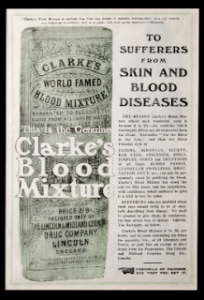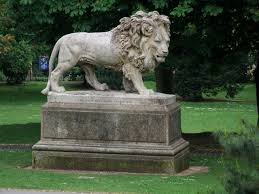This very interesting talk was a darkly humorous look at medicine in the 19th century when ‘chemists’ (and I use that word lightly) mixed all sorts of lethal concoctions together including laudanum, morphine, coca leaves, heroin and arsenic and made their fortunes despite blatantly selling these noxious doses of over- the- counter poisons as cure-alls.
I thought it might interest you to know that one of these so-called ‘chemists’ was an enterprising young man from Lincoln called Francis Clarke. At the age of 17, he decided to follow in his ‘chemist’ father’s footsteps so, he rented a shop at 35 Newland and, after mixing various ‘medicinal compounds’, he eventually ‘invented’ and patented the extremely popular Clarke’s World Famous Blood Mixture.
By 1868, the demand for his product was so great that he had to move to larger premises at 215 High Street which he named Apothecaries Hall. Literally hundreds of thousands of people bought his ‘blood purifier’ which he claimed could cure sores, glandular swelling, skin complaints, scurvy, cancerous ulcers, rheumatism, gout, sore eyes, dropsy and pimples to name but a few.
 Although advertised as ‘The finest blood purifier that science and medical skill have brought to light’, it was of very questionable medical benefit since its contents apparently consisted of mainly water mixed with a little sugar, a miniscule amount of alcohol and traces of ammonia and chloroform. The cost of the ingredients for a standard bottle were estimated at one old penny yet the product was being sold for much, much more than that and, it was available in the United Kingdom until 1968.
Although advertised as ‘The finest blood purifier that science and medical skill have brought to light’, it was of very questionable medical benefit since its contents apparently consisted of mainly water mixed with a little sugar, a miniscule amount of alcohol and traces of ammonia and chloroform. The cost of the ingredients for a standard bottle were estimated at one old penny yet the product was being sold for much, much more than that and, it was available in the United Kingdom until 1968.
 By 1870, Francis had formed the Lincoln and Midland Counties Drug Company based in Park Street and which continued trading for about another 100 years. Needless to say, during his lifetime, Francis became a rich man, was Mayor of Lincoln three times, a Justice of the Peace and, built Bracebridge Hall where he lived until his death aged only 46 in 1888. He did, however, also give generously to numerous local charities and good causes, paid for the Coade stone lion in the Arboretum, was instrumental in removing a row of houses along St Mary’s Street which impeded access to the Great Northern Railway Station and, pushed forward the scheme proposed in 1854 by Richard Carline to create Yarborough Road.
By 1870, Francis had formed the Lincoln and Midland Counties Drug Company based in Park Street and which continued trading for about another 100 years. Needless to say, during his lifetime, Francis became a rich man, was Mayor of Lincoln three times, a Justice of the Peace and, built Bracebridge Hall where he lived until his death aged only 46 in 1888. He did, however, also give generously to numerous local charities and good causes, paid for the Coade stone lion in the Arboretum, was instrumental in removing a row of houses along St Mary’s Street which impeded access to the Great Northern Railway Station and, pushed forward the scheme proposed in 1854 by Richard Carline to create Yarborough Road.
Despite international recognition for his aesculapian product, Francis is a virtually unknown philanthropic Lincolnite who obviously had a genuine interest in the well being of the City and the improvement of its roads and housing.

Leave a Reply
You must be logged in to post a comment.